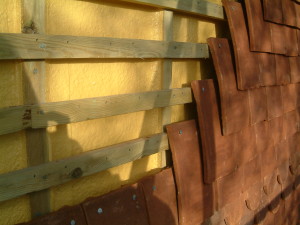
By Leonie Onslow, Executive Director, British Urethane Foam Contractors Association
Specifiers need to realise the potential in energy efficiency investment to achieve ongoing cost savings for property owners. In addition to reducing running costs higher market values can be achieved when increasing the property’s energy efficiency performance.
Closed cell polyurethane foam insulation for building projects has been around for over 30 years. The polyurethane insulant is a two-component liquid system which produces a highly-efficient blanket of insulation with an exceptional thermal conductivity figure. It is particularly cost-effective and easy to apply to a wide variety of substrates. Its closed-cell nature renders it very resistant to moisture ingress.
The insulation value of polyurethane foam is amongst the best available as the foam seals all gaps and moulds itself to all contours. It has the ability to provide significant structural strength and it creates its own vapour control layer – essential in today’s highly insulated buildings.
The trade association for the sprayed and injected polyurethane foam industry is the British Urethane Foam Contractors Association. BUFCA is a central resource for the application of polyurethane foam systems. The association consists of polyurethane foam installers operating to high standards, together with material and equipment suppliers.
Polyurethane foam can be installed for air tightness and to help meet Building Regulations as wall insulation, roof insulation, floor insulation or to fill voids and other areas providing a seamless, thermal insulation barrier. Other jointed systems give rise to a potentially weak point, leading to a significant loss of insulation value.
For instance, polyurethane foam can be economically applied to the underside of traditional residential roofs, as well as those constructed from steel, asbestos and aluminium. Systems can be applied to various depths and have K-values in the range of 0.025 – 0.028W/mK.
When sprayed to a depth of 100mm, the U-value of a typical roof with 100mm fibreglass at ceiling level is reduced from 0.34W/m²K to 0.16W/m²K bringing the building up to current Building Regulation requirements. This can save the equivalent of more than one tonne of CO2 per annum by reducing energy consumption.
Polyurethane foam is not just an insulant – it can be used for stabilisation purposes, for instance to hold tiles in place for a stronger roof structure or to take the place of failing wall ties. The material can often be used when other materials are not suitable. Some of the types of applications are outlined below but actually the material is so versatile that it can be used in many more!
For wall insulation, injected polyurethane foam can be used in the cavity to provide a superior performing insulant which also helps to bond the inner and outer leaves providing strength to the building. Air leakage through the cavity can be reduced to zero. Because of the greater thermal performance and the reduced air leakage PU foam outperforms all other forms of cavity fill.
Polyurethane foam systems provide the ideal solution for industrial and commercial buildings as large areas can be insulated quickly for insulation and condensation control. Factories, warehouses, exhibition halls, football stadiums and offices can all be insulated.
Where buildings have been subject to a change of use spray-applied and injected polyurethane can achieve high U-values outperforming many other insulants. The insulant can be applied to most building substrates and will fill voids which might otherwise be difficult to reach with other materials.
Closed cell foams are resistant to driving rain meaning that the material stays dry with no loss of thermal properties. The insulant can help act as a barrier to prevent flood waters from entering the building through the walls. The British Board of Agrément certification approves this insulant for cavity walls in all exposure zones. Closed cell foams which achieve a Class 1 fire rating when tested to BS476 Part 7 are available. Or, where non-Class 1 materials are used on internal applications these must be covered by plasterboard, or a similar thermal barrier.
Conversely, open cell polyurethane foams do not have the high insulation properties associated with the closed cell materials, which is a distinct disadvantage if trying to save space. They do not have the same fire performance as closed cell, so they should never be left exposed; they have no structural strength to stabilise roofs or walls and are widely marketed to be applied directly onto non-breathable membranes. This practice should be treated with a high degree of caution as interstitial condensation could occur in the foam, next to roof timbers.
However, they are better suited for their enhanced sound attenuation properties. Open cell foam is also useful in situations which require more air and vapour into a building’s interior. Where open cell materials are used, the installation thickness can be increased for better thermal performance but if the primary purpose is energy efficiency, then the closed cell option is normally preferable.
BUFCA celebrated its 30th anniversary in March 2016. Peter Bristow, the BUFCA Chairman explained, “As a small trade association, we are pleased to have reached this important milestone – now we can build on our solid foundations to further develop the polyurethane foam market across a range of sectors. Insulation of the building fabric has the most potential to make energy efficiency savings in the UK, improve comfort and reduce the carbon footprint. The walls and roof are normally the greatest areas of heat loss.”
The British Urethane Foam Contractors Association represents sprayed and injected polyurethane foam installers. To find an installer offering excellent advice and quality installations visit the BUFCA website at: www.bufca.co.uk. Technical datasheets are also available on the website and freely available for specifiers.

